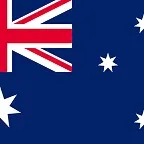
New Zealand
New Zealand (Māori: Aotearoa) is an island country in the southwestern Pacific Ocean. It consists of two main landmasses—the North Island (Te Ika-a-Māui) and the South Island (Te Waipounamu)—and over 600 smaller islands. It is the sixth-largest island country by area and lies east of Australia across the Tasman Sea and south of the islands of New Caledonia, Fiji, and Tonga. The country's varied topography and sharp mountain peaks, including the Southern Alps (Kā Tiritiri o te Moana), owe much to tectonic uplift and volcanic eruptions. New Zealand's capital city is Wellington, and its most populous city is Auckland.
The islands of New Zealand were the last large habitable land to be settled by humans. Between about 1280 and 1350, Polynesians began to settle in the islands and subsequently developed a distinctive Māori culture. In 1642, the Dutch explorer Abel Tasman became the first European to sight and record New Zealand. In 1769 the British explorer Captain James Cook became the first European to set foot on and map New Zealand. In 1840, representatives of the United Kingdom and Māori chiefs signed the Treaty of Waitangi which paved the way for Britain's declaration of sovereignty later that year and the establishment of the Crown Colony of New Zealand in 1841. Subsequently, a series of conflicts between the colonial government and Māori tribes resulted in the alienation and confiscation of large amounts of Māori land. New Zealand became a dominion in 1907; it gained full statutory independence in 1947, retaining the monarch as head of state. Today, the majority of New Zealand's population of around 5.3 million is of European descent; the indigenous Māori are the largest minority, followed by Asians and Pasifika. Reflecting this, New Zealand's culture is mainly derived from Māori and early British settlers but has recently broadened from increased immigration. The official languages are English, Māori, and New Zealand Sign Language, with the local dialect of English being dominant.
A developed country, New Zealand was the first to introduce a minimum wage and give women the right to vote. It ranks very highly in international measures of quality of life and human rights and has one of the lowest levels of perceived corruption in the world. It retains visible levels of inequality, including structural disparities between its Māori and European populations. New Zealand underwent major economic changes during the 1980s, which transformed it from a protectionist to a liberalised free-trade economy. The service sector dominates the country's economy, followed by the industrial sector, and agriculture; international tourism is also a significant source of revenue. New Zealand and Australia have a strong relationship and are considered to share a strong Trans-Tasman identity, stemming from centuries of British colonisation. The country is part of multiple international organizations and forums.
Nationally, legislative authority is vested in an elected, unicameral Parliament, while executive political power is exercised by the Government, led by the prime minister, currently Christopher Luxon. Charles III is the country's king and is represented by the governor-general, Cindy Kiro. New Zealand is organised into 11 regional councils and 67 territorial authorities for local government purposes. The Realm of New Zealand also includes Tokelau (a dependent territory); the Cook Islands and Niue (self-governing states in free association with New Zealand); and the Ross Dependency, which is New Zealand's territorial claim in Antarctica.
Etymology

The first European visitor to New Zealand, Dutch explorer Abel Tasman, named the islands Staten Land, believing they were part of the Staten Landt that Jacob Le Maire had sighted off the southern end of South America.[18][19] The next year, in 1643, Hendrik Brouwer proved that the South American land was just a small island, and Dutch cartographers subsequently renamed Tasman's discovery Nova Zeelandia from Latin, after the Dutch province of Zeeland.[18][20] This name was later anglicised to New Zealand.[21][22]
This was written as Nu Tireni in the Māori language (spelled Nu Tirani in Te Tiriti o Waitangi). In 1834, a document written in Māori and entitled "He Wakaputanga o te Rangatiratanga o Nu Tireni" was translated into English and became the Declaration of the Independence of New Zealand. It was prepared by Te W(h)akaminenga o Nga Rangatiratanga o Nga Hapu o Nu Tireni, the United Tribes of New Zealand, and a copy was sent to King William IV who had already acknowledged the flag of the United Tribes of New Zealand, and who recognised the declaration in a letter from Lord Glenelg.[23][24]
Aotearoa (pronounced [aɔˈtɛaɾɔa] in Māori and /ˌaʊtɛəˈroʊ.ə/ in English; often translated as 'land of the long white cloud')[25] is the current Māori name for New Zealand. It is unknown whether Māori had a name for the whole country before the arrival of Europeans; Aotearoa originally referred to just the North Island.[26] Māori had several traditional names for the two main islands, including Te Ika-a-Māui ('the fish of Māui') for the North Island and Te Waipounamu ('the waters of greenstone') or Te Waka o Aoraki ('the canoe of Aoraki') for the South Island.[27] Early European maps labelled the islands North (North Island), Middle (South Island), and South (Stewart Island / Rakiura).[28]
In 1830, mapmakers began to use "North" and "South" on their maps to distinguish the two largest islands, and by 1907, this was the accepted norm.[22] The New Zealand Geographic Board discovered in 2009 that the names of the North Island and South Island had never been formalised, and names and alternative names were formalised in 2013. This set the names as North Island or Te Ika-a-Māui, and South Island or Te Waipounamu.[29] For each island, either its English or Māori name can be used, or both can be used together.[29] Similarly the Māori and English names for the whole country are sometimes used together (Aotearoa New Zealand);[30][31] however, this has no official recognition.[32]
History

The first people to reach New Zealand were Polynesians in ocean going waka, who are believed to have arrived in several waves, approximately between 1280 and 1350 CE. According to most Māori oral traditions, the islands were first discovered by the semi-legendary explorer Kupe while in pursuit of a giant octopus.[36] These traditions held that Kupe was then followed by a great fleet of settlers, who set out from Hawaiki in eastern Polynesia in around 1350.[37] The existence of a single great fleet which settled New Zealand has since been superseded by the belief that the majority of settlement was a planned and deliberate event that occurred over several decades.[38][39][40][41][42]
The exact date of this settlement is unclear, with recent sources favouring settlement in the 14th century. While mitochondrial DNA variability within Māori populations suggest that New Zealand was first settled between 1250 and 1300,[27][43][44] no human remains, artefacts or structures can be reliably dated to earlier than the Kaharoa eruption of Mount Tarawera in around 1314 CE.[45] This scenario is also consistent with a debated third line of oral evidence,[46] traditional genealogies (whakapapa) which point to around 1350 as a probable arrival date for several of the migratory waka (canoes) from which many Māori trace their descent.[47][48] Some Māori later migrated to the Chatham Islands where they developed their distinct Moriori culture;[49] a later 1835 invasion by Māori iwi resulted in the massacre and virtual extinction of the Moriori.[50]
In a hostile 1642 encounter between Ngāti Tūmatakōkiri and Dutch explorer Abel Tasman's crew,[51][52] four of Tasman's crew members were killed, and at least one Māori was hit by canister shot.[53] Europeans did not revisit New Zealand until 1769, when British explorer James Cook mapped almost the entire coastline.[52] Following Cook, New Zealand was visited by numerous European and North American whaling, sealing, and trading ships. They traded European food, metal tools, weapons, and other goods for timber, Māori food, artefacts, and water.[54]
The introduction of the potato and the musket transformed Māori agriculture and warfare. Potatoes provided a reliable food surplus, which enabled longer and more sustained military campaigns.[55] The resulting intertribal Musket Wars encompassed over 600 battles between 1801 and 1840, killing 30,000–40,000 Māori.[56] From the early 19th century, Christian missionaries began to settle New Zealand, eventually converting most of the Māori population.[57] The Māori population declined to around 40% of its pre-contact level during the 19th century; introduced diseases were the major factor.[58]







